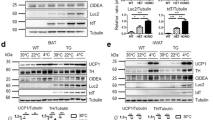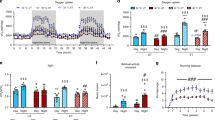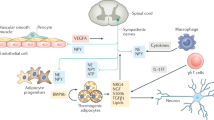Abstract
Objectives:
Obesity-related cancers represent public health burdens of the first order. Nevertheless, suitable mouse models to unravel molecular mechanisms linking obesity to human cancer are still not available. One translational model is the immunocompromised Foxn1 (winged-helix/forkead transcription factor) nude mouse transplanted with human tumor xenografts. However, most xenograft studies are conducted in nude mice on an in-bred BALB/c background that entails protection from diet-induced obesity. To overcome such resistance to obesity and its sequelae, we here propose the dual strategy of utilizing Foxn1 nude mice on a C57BL/6 background and housing them at their thermoneutral zone.
Methods:
C57BL/6 nude and corresponding wild-type mice, housed at 23 or 33 °C, were subjected to either low-fat diet or high-fat diet (HFD). Energy expenditure, locomotor activity, body core temperature, respiratory quotient as well as food and water intake were analyzed using indirect calorimetry. Immune function at different housing temperatures was assessed by using an in vivo cytokine capture assay.
Results:
Our data clearly demonstrate that conventional housing protects C57BL/6 nude mice from HFD-induced obesity, potentially via increased energy expenditure. In contrast, HFD-fed C57BL/6 nude mice housed at thermoneutral conditions develop adiposity, increased hepatic triglyceride accumulation, adipose tissue inflammation and glucose intolerance. Moreover, increased circulating levels of lipopolysaccharide-driven cytokines suggest a greatly enhanced immune response in C57BL/6 nude mice housed at thermoneutrality.
Conclusion:
Our data reveals mild cold stress as a major modulator for energy and body weight homeostasis as well as immune function in C57BL/6 nude mice. Adjusting housing temperatures to the thermoneutral zone may ultimately be key to successfully study growth and progression of human tumors in a diet-induced obese environment.
This is a preview of subscription content, access via your institution
Access options
Subscribe to this journal
Receive 12 print issues and online access
$259.00 per year
only $21.58 per issue
Buy this article
- Purchase on Springer Link
- Instant access to full article PDF
Prices may be subject to local taxes which are calculated during checkout




Similar content being viewed by others
References
WHO. Obesity and Overweight, Fact Sheet No. 311, 2008. http://www.who.int/mediacentre/factsheets/fs311/en/.
Unger RH, Clark GO, Scherer PE, Orci L . Lipid homeostasis, lipotoxicity and the metabolic syndrome. Biochim Biophys Acta 2010; 1801: 209–214.
Calle EE, Rodriguez C, Walker-Thurmond K, Thun MJ . Overweight, obesity, and mortality from cancer in a prospectively studied cohort of U.S. adults. N Engl J Med 2003; 348: 1625–1638.
Bianchini F, Kaaks R, Vainio H . Overweight, obesity, and cancer risk. Lancet Oncol 2002; 3: 565–574.
Calle EE, Kaaks R . Overweight, obesity and cancer: epidemiological evidence and proposed mechanisms. Nat Rev Cancer 2004; 4: 579–591.
Khandekar MJ, Cohen P, Spiegelman BM . Molecular mechanisms of cancer development in obesity. Nat Rev Cancer 2011; 11: 886–895.
Richmond A, Su Y . Mouse xenograft models vs GEM models for human cancer therapeutics. Dis Model Mech 2008; 1: 78–82.
Flanagan SP . 'Nude', a new hairless gene with pleiotropic effects in the mouse. Genet Res 1966; 8: 295–309.
Kelland LR . Of mice and men: values and liabilities of the athymic nude mouse model in anticancer drug development. Eur J Cancer 2004; 40: 827–836.
Kerbel RS . Human tumor xenografts as predictive preclinical models for anticancer drug activity in humans: better than commonly perceived-but they can be improved. Cancer Biol Ther 2003; 2 (Suppl 1): S134–S139.
Bibby MC . Orthotopic models of cancer for preclinical drug evaluation: advantages and disadvantages. Eur J Cancer 2004; 40: 852–857.
Montgomery MK, Hallahan NL, Brown SH, Liu M, Mitchell TW, Cooney GJ et al. Mouse strain-dependent variation in obesity and glucose homeostasis in response to high-fat feeding. Diabetologia 2013; 56: 1129–1139.
Waller-Evans H, Hue C, Fearnside J, Rothwell AR, Lockstone HE, Calderari S et al. Nutrigenomics of high fat diet induced obesity in mice suggests relationships between susceptibility to fatty liver disease and the proteasome. PLoS One 2013; 8: e82825.
Tschop M, Heiman ML . Overview of rodent models for obesity research. Curr Protoc Neurosci 2002; Chapter 9 (Unit 9.10).
Kahle M, Horsch M, Fridrich B, Seelig A, Schultheiss J, Leonhardt J et al. Phenotypic comparison of common mouse strains developing high-fat diet-induced hepatosteatosis. Mol Metab 2013; 2: 435–446.
Weir JB . New methods for calculating metabolic rate with special reference to protein metabolism. J Physiol 1949; 109: 1–9.
Frayn KN, Maycock PF . Skeletal muscle triacylglycerol in the rat: methods for sampling and measurement, and studies of biological variability. J Lipid Res 1980; 21: 139–144.
Storlien LH, Jenkins AB, Chisholm DJ, Pascoe WS, Khouri S, Kraegen EW . Influence of dietary fat composition on development of insulin resistance in rats. Relationship to muscle triglyceride and omega-3 fatty acids in muscle phospholipid. Diabetes 1991; 40: 280–289.
Harley IT, Stankiewicz TE, Giles DA, Softic S, Flick LM, Cappelletti M et al. IL-17 signaling accelerates the progression of nonalcoholic fatty liver disease in mice. Hepatology 2013; 59: 1830–1839.
Finkelman F, Morris S, Orekhova T, Sehy D . The in vivo cytokine capture assay for measurement of cytokine production in the mouse. Curr Protoc Immunol 2003; Chapter 6 (Unit 6.28).
Karp CL . Unstressing intemperate models: how cold stress undermines mouse modeling. J Exp Med 2012; 209: 1069–1074.
Dawson NJ . The surface-area-body-weight relationship in mice. Aust J Biol Sci 1967; 20: 687–690.
Cannon B, Nedergaard J . Nonshivering thermogenesis and its adequate measurement in metabolic studies. J Exp Biol 2011; 214 (Pt 2): 242–253.
David JM, Chatziioannou AF, Taschereau R, Wang H, Stout DB . The hidden cost of housing practices: using noninvasive imaging to quantify the metabolic demands of chronic cold stress of laboratory mice. Comp Med 2013; 63: 386–391.
Cannon B, Nedergaard J . Thermogenesis challenges the adipostat hypothesis for body-weight control. Proc Nutr Soc 2009; 68: 401–407.
Speakman JR, Keijer J . Not so hot: optimal housing temperatures for mice to mimic the thermal environment of humans. Mol Metab 2012; 2: 5–9.
Ravussin Y, Xiao C, Gavrilova O, Reitman ML . Effect of intermittent cold exposure on brown fat activation, obesity, and energy homeostasis in mice. PLoS One 2014; 9: e85876.
Woods SC, Schwartz MW, Baskin DG, Seeley RJ . Food intake and the regulation of body weight. Annu Rev Psychol 2000; 51: 255–277.
Jouda J, Wildmann J, Schafer M, Roggero E, Besedovsky HO, del Rey A . T cells affect central and peripheral noradrenergic mechanisms and neurotrophin concentration in the spleen and hypothalamus. Ann NY Acad Sci 2012; 1261: 18–25.
Pardon MC, Ma S, Morilak DA . Chronic cold stress sensitizes brain noradrenergic reactivity and noradrenergic facilitation of the HPA stress response in Wistar Kyoto rats. Brain Res 2003; 971: 55–65.
Kokolus KM, Capitano ML, Lee CT, Eng JW, Waight JD, Hylander BL et al. Baseline tumor growth and immune control in laboratory mice are significantly influenced by subthermoneutral housing temperature. Proc Natl Acad Sci USA 2013; 110: 20176–20181.
Cani PD, Amar J, Iglesias MA, Poggi M, Knauf C, Bastelica D et al. Metabolic endotoxemia initiates obesity and insulin resistance. Diabetes 2007; 56: 1761–1772.
Cani PD, Bibiloni R, Knauf C, Waget A, Neyrinck AM, Delzenne NM et al. Changes in gut microbiota control metabolic endotoxemia-induced inflammation in high-fat diet-induced obesity and diabetes in mice. Diabetes 2008; 57: 1470–1481.
Harmey JH, Bucana CD, Lu W, Byrne AM, McDonnell S, Lynch C et al. Lipopolysaccharide-induced metastatic growth is associated with increased angiogenesis, vascular permeability and tumor cell invasion. Int J Cancer 2002; 101: 415–422.
Chicoine MR, Zahner M, Won EK, Kalra RR, Kitamura T, Perry A et al. The in vivo antitumoral effects of lipopolysaccharide against glioblastoma multiforme are mediated in part by Toll-like receptor 4. Neurosurgery 2007; 60: 372–380, discussion 381.
Andreani V, Gatti G, Simonella L, Rivero V, Maccioni M . Activation of Toll-like receptor 4 on tumor cells in vitro inhibits subsequent tumor growth in vivo. Cancer Res 2007; 67: 10519–10527.
Munford RS . Murine responses to endotoxin: another dirty little secret? J Infect Dis 2010; 201: 175–177.
Warren HS, Fitting C, Hoff E, Adib-Conquy M, Beasley-Topliffe L, Tesini B et al. Resilience to bacterial infection: difference between species could be due to proteins in serum. J Infect Dis 2010; 201: 223–232.
Acknowledgements
This work was supported by the German Research Foundation (STE 1466/4-1) (to KS) and, in part, by a NIH R21-HL113907 and R01-DK099222 (to SD).
Author information
Authors and Affiliations
Corresponding author
Ethics declarations
Competing interests
The authors declare no conflict of interest.
Additional information
Supplementary Information accompanies this paper on International Journal of Obesity website
Rights and permissions
About this article
Cite this article
Stemmer, K., Kotzbeck, P., Zani, F. et al. Thermoneutral housing is a critical factor for immune function and diet-induced obesity in C57BL/6 nude mice. Int J Obes 39, 791–797 (2015). https://doi.org/10.1038/ijo.2014.187
Received:
Revised:
Accepted:
Published:
Issue Date:
DOI: https://doi.org/10.1038/ijo.2014.187
This article is cited by
-
Sex differences in energy metabolism: natural selection, mechanisms and consequences
Nature Reviews Nephrology (2024)
-
Green tea beneficial effects involve changes in the profile of immune cells in the adipose tissue of obese mice
European Journal of Nutrition (2023)
-
Mouse models of nonalcoholic steatohepatitis and their application to new drug development
Archives of Pharmacal Research (2022)
-
Mice as experimental models for human physiology: when several degrees in housing temperature matter
Nature Metabolism (2021)
-
Role of dietary fat on obesity-related postmenopausal breast cancer: insights from mouse models and methodological considerations
Breast Cancer (2021)



